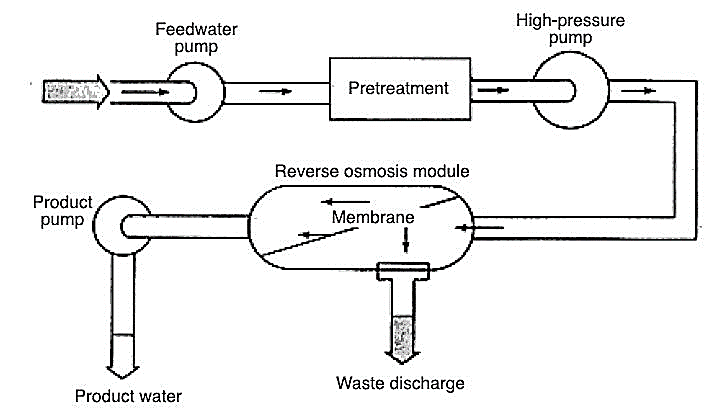
Seawater Desalination with Reverse Osmosis Plant
All Reverse Osmosis crops are generally Desalination Crops but desalination is getting referred to sea drinking water normally.As sea water has quite superior TDS needs quite superior pressure to power sea drinking water by way of membranes which are various then brackish drinking water membranes.
Reverse Osmosis Plant Information:
A reverse osmosis plant is usually a producing plant, where h2o is purified and desalinated by forcing h2o via a membrane, typically referred to as a reverse osmosis method. Water produced by plant RO might be used for a number of functions like desalination, wastewater therapy, as well as the reclamation of dissolved minerals.
RO Plant Description
An average drinking h2o RO plant process involves six KW hours of electricity to desalinate one cubic meter of h2o. Reverse osmosis drinking water plants necessitates several different pre-cure approaches like softening, DE chlorination, and anti-scale remedy. Following pre-procedure, substantial levels of tension ship water by way of a semi-permeable membrane, which holds all contaminants other than water.
RO Plant Structure
To reinforce the performance and life of the Reverse Osmosis plant, effective pretreatment with the feed water is needed. Choice of the ideal pretreatment will increase performance and membrane existence by lessening:
Fouling
Scaling
Membrane Degradation
RO plant design and style is consisting of:
Determining pretreatment necessity of Reverse Osmosis Plant
Should the feed water has traces of significant metals, it is very advised to dose some chlorine to alter the dissolved heavy metals to Bodily sort, the media filter will filter the majority of it in the ro h2o purifier plant.
Reverse Osmosis Plant Choice of membrane
Membrane aspects are a very important A part of RO vegetation. The proteins (primarily polyamide) that make-up membrane features vary with regards to the ending clarity and consumption drinking water seawater or brackish drinking water etcetera
Waterman engineers Australia RO plant for seawater desalination
Waterman Engineers in Australia has designed a Reverse Osmosis (RO) plant for seawater desalination, which provides numerous rewards in excess of other desalination procedures. Below are a few vital great things about their RO plant:
Electrical power Performance:
Compared to other desalination techniques like thermal distillation, RO requires less energy. Waterman Engineers' RO plant makes use of Highly developed membrane technological know-how, allowing for it to work at decrease pressures Desalination Plant Manufacturer and minimize General energy use.
Environmental Impression:
RO generates considerably less brine discharge in comparison with thermal techniques, reducing the influence on marine ecosystems. This aligns with Australia's deal with environmental sustainability and conservation.
Substantial Water Purity:
The RO system properly removes salts, minerals, and impurities, manufacturing large-high-quality freshwater that fulfills stringent ingesting water benchmarks. This reliability is very important for offering Harmless and clear h2o to communities.
Modular Style:
Waterman Engineers' RO plant employs a modular style and design, permitting for scalability and suppleness. This is especially advantageous for regions with different h2o demands, as modules might be included or adjusted accordingly.
Diminished Footprint:
RO crops generally Possess a scaled-down Actual physical footprint in comparison to thermal desalination plants, which regularly call for considerable infrastructure for heating and cooling procedures.
Fast Commence-Up and Shutdown:
RO vegetation might be started off and stopped rather quickly, permitting for far better responsiveness to shifting drinking water needs and emergencies.
Decrease Chemical Utilization:
Not like Various other desalination approaches, RO calls for less chemical substances for operation and cleansing, reducing chemical-relevant environmental worries.
Consistency in Overall performance:
The RO procedure is less delicate to feedwater excellent fluctuations than other approaches, making certain a far more reliable effectiveness after a while.
Expense-Effectiveness:
Though First investment decision costs is often important, RO plants are inclined to possess lessen operational and upkeep prices Eventually in comparison with thermal solutions.
Reverse Osmosis (RO) can be a h2o purification method that takes advantage of a partially permeable membrane to get rid of ions, unwanted molecules, and larger particles from consuming h2o. By applying strain to beat osmotic pressure, it makes it possible for the passage of h2o molecules whilst rejecting contaminants, therefore developing thoroughly clean drinking water on just one facet from the membrane and concentrated impurities on the opposite.
The Doing the job basic principle of a Reverse Osmosis (RO) plant requires making use of force to the saline Answer to power drinking water molecules by way of a semi-permeable membrane. This membrane lets only h2o to go though rejecting salts, contaminants, and impurities, causing purified h2o on the permeate side along with a concentrated Remedy of contaminants about the brine aspect.
The benefits of Reverse Osmosis incorporate manufacturing significant-excellent, clean up drinking water by taking away contaminants, currently being successful and value-successful with time, requiring minimal chemical use, and remaining adaptable to numerous scales of operation from little home systems to significant municipal vegetation.
RO plants have changed Demineralisation (DM) vegetation simply because they frequently give a far more productive and cost-productive Remedy for water purification. RO devices Never require the regeneration substances that resin-primarily based DM crops do and may remove a broader variety of contaminants, such as dissolved solids and microorganisms.
Waterman Engineers Australia possible employs Reverse Osmosis (RO) crops for seawater desalination by forcing seawater through a semi-permeable membrane to eliminate salt along with other impurities. This method produces clean, potable h2o from your ocean, addressing h2o scarcity and supplying a sustainable offer for various wants.